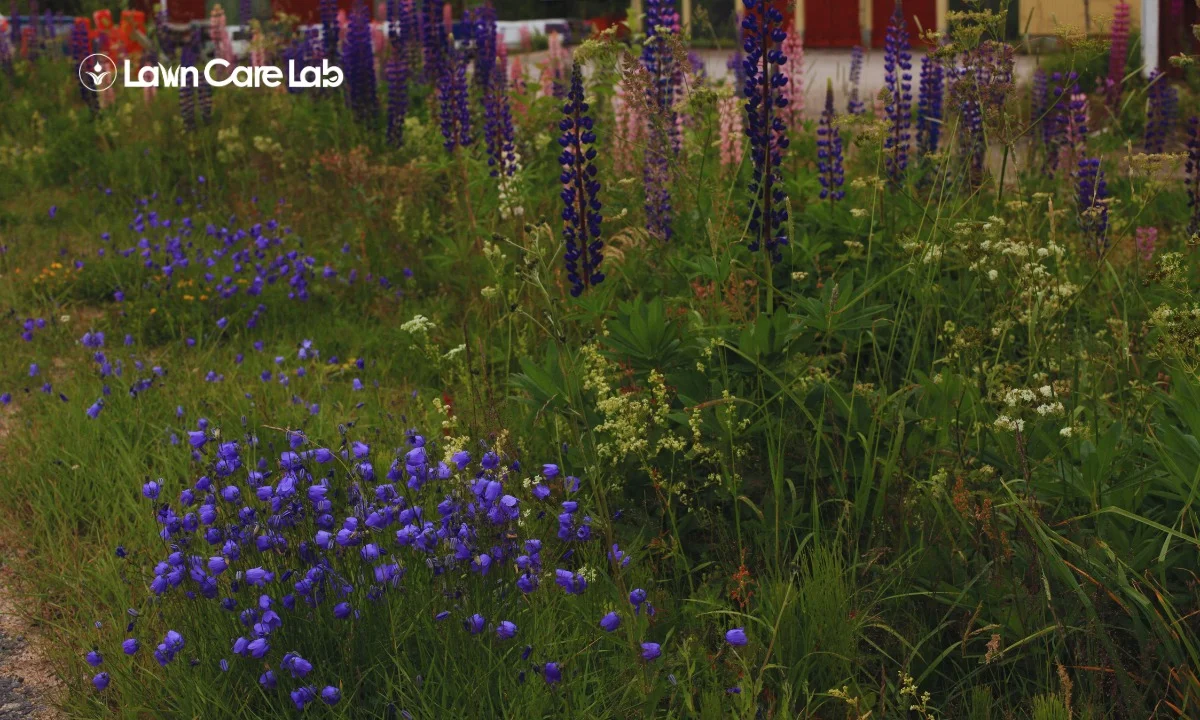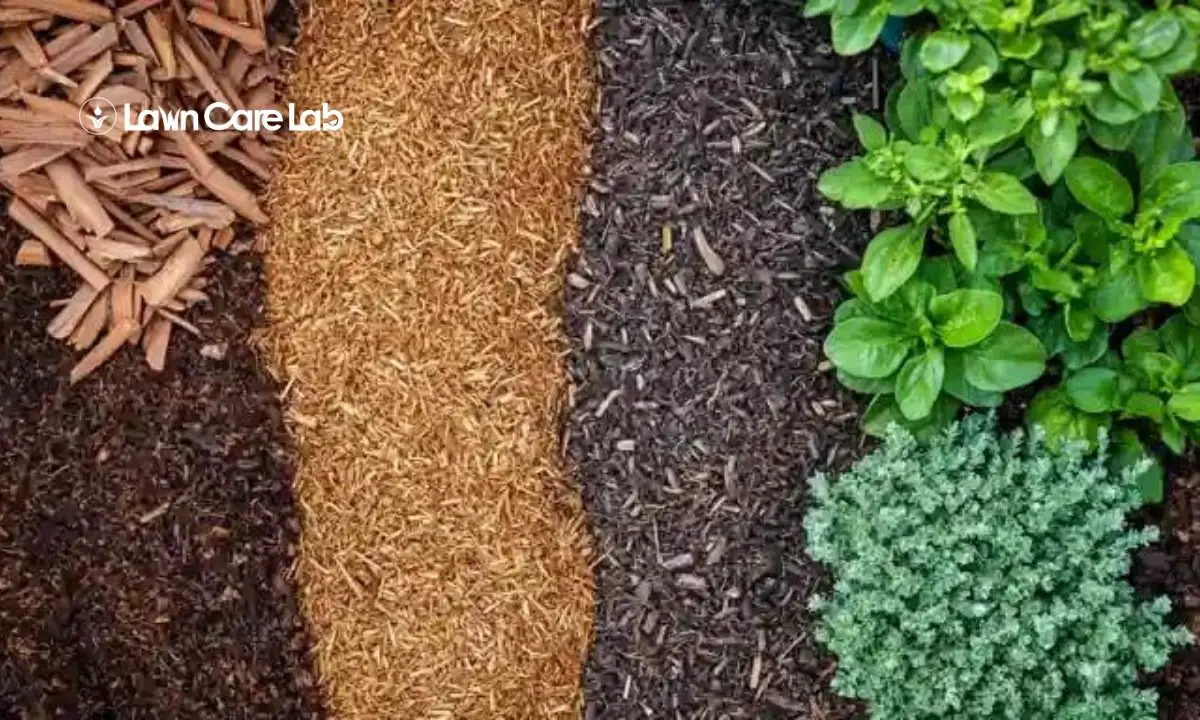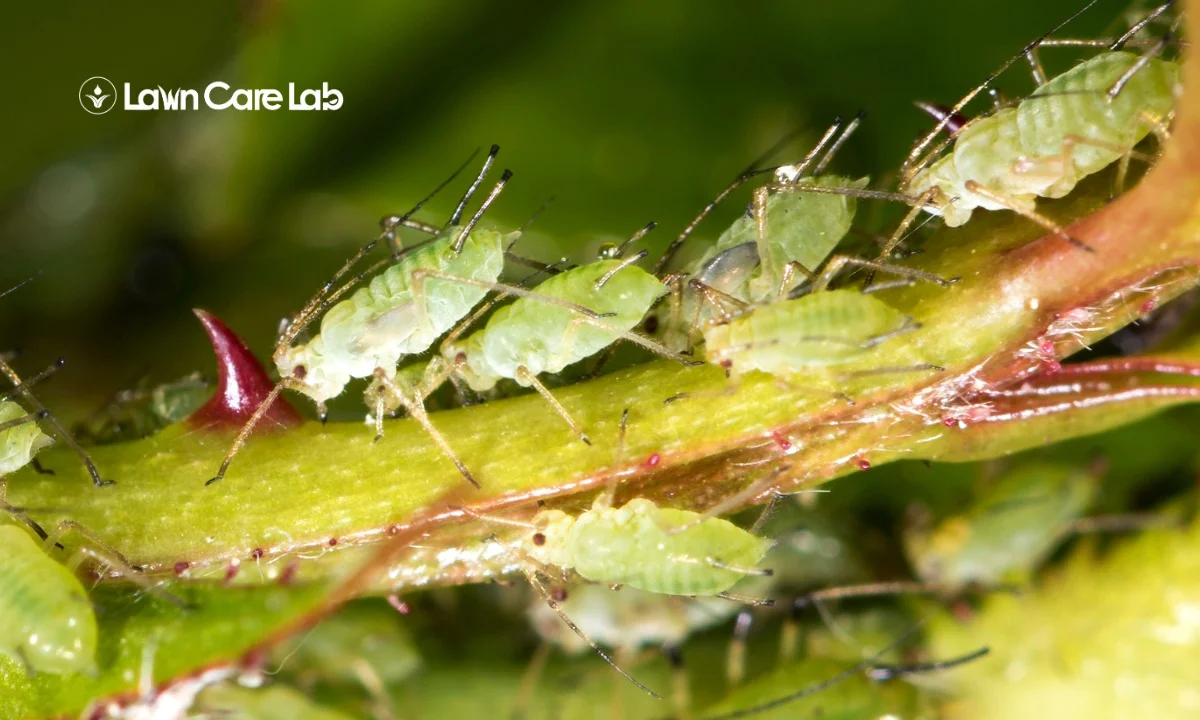You might not realize it, but you’re silently struggling with invasive plants. They’re bold, infiltrating your yard and throwing off the balance of our natural ecosystems. But don’t wave the white flag yet. You’re fully capable of turning things around.
All you need is a bit of know-how, a strategic plan, and a willingness to put in some work.
Let’s dive into the strategies Against Invasive plants and equip you with the necessary tools to triumph in this green battleground.
Table of Contents
The Battle Beneath Our Feet
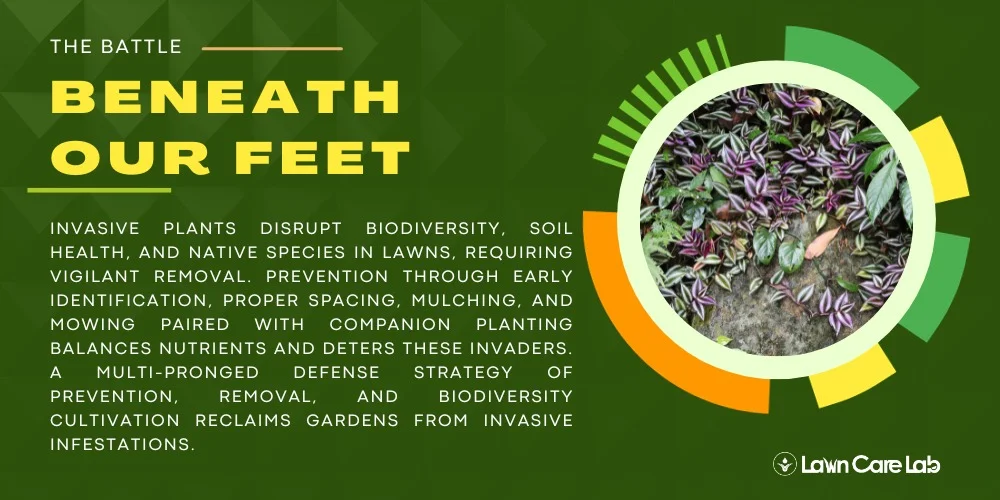
Welcome to the silent clash that garden enthusiasts and property owners are fighting: the war against invasive species.
These pretty-looking intruders are a major risk to your garden’s biodiversity, throwing off the balance and snatching resources from indigenous plants.
This conflict isn’t a myth; learning about these invaders’ tactics is key to a successful counterattack.
Understanding invasive plants and their impact on lawns
Invasive plants may be the reason your lawn isn’t green despite your efforts in watering and fertilizing it. They grow quickly, force out native plants, disrupt the ecosystem, and change soil composition.
Pests can damage your lawn’s appearance and curb appeal. Awareness of these threats is essential to create effective defense strategies.
Keeping a beautiful garden is not just about appearance, it’s also about conserving biodiversity and promoting healthy soil. Let’s explore the challenge of keeping the garden beautiful despite unwelcome invaders.
The challenge of maintaining a garden amidst invaders
Invasive plants can harm biodiversity and cause nutrient loss, making garden maintenance crucial.
Here’s a straightforward guide:
| Ways to Prevent | Methods of Removal | Role of Companion Planting |
|---|---|---|
| Regular checks | Pulling out by hand | Enhancing diversity |
| Using mulch | Specialized tools | Deterring pests |
| Biological solutions | Throwing away properly | Balancing nutrients |
| Proper spacing between plants | Weeding regularly | Boosting soil health |
| Looking after soil health | Mowing at the right time | Supporting each other’s growth |
Merging preventive measures, removal methods, and knowing the benefits of planting different plants together can help you win this battle. Remember, the goal isn’t just to fight but to conquer this hidden war.
Recognizing Common Invasive Plant Species
To successfully fight off invasive plants, it’s crucial to understand what you’re dealing with. Learn the features that make a plant invasive, like quick expansion or the knack to overpower local species.
Concentrate on well-known garden intruders in your area to enhance the effectiveness of your efforts.
Traits and characteristics of invasive plants
Invasive plants are easy to spot due to their speedy growth and widespread presence, which sets them apart as true invaders.
They outcompete native species thanks to their abundant seed output and the absence of natural enemies.
Comprehending these features is crucial in spotting typical invasive flora and crafting effective methods to fight back.
Rapid growth and spread: Hallmarks of invaders.
Invasive plants spread quickly. Control measures should start early, prevent their spread, identify species, and restore the ecosystem.
By effectively addressing these aspects, we can stop the dominance of invasive species.
Now, let’s dig deeper into how these intruders outmaneuver native plants.
How invasive species outcompete native plants
You might be puzzled about how invasive species can outshine native plants despite efforts to control them. It’s a game of survival revolving around competition dynamics and the battle for resources.
Understanding the resilience of native plants and the ecological consequences is key to managing these invasive species. They utilize their rapid growth to dominate the slower native plants, especially those without unique protective mechanisms.
A brief overview of notorious lawn invaders
Unwelcome guests like kudzu, Japanese stilt grass, garlic mustard, purple loosestrife, and lesser celandine can harm your yard’s soil health and trigger negative ecological effects.
To identify pests, look for fast-spreading growth, unique appearances, changes in soil quality, and disruptions in biodiversity. Taking action can help restore your lawn’s vitality.
Why Invasive Plants are a Problem
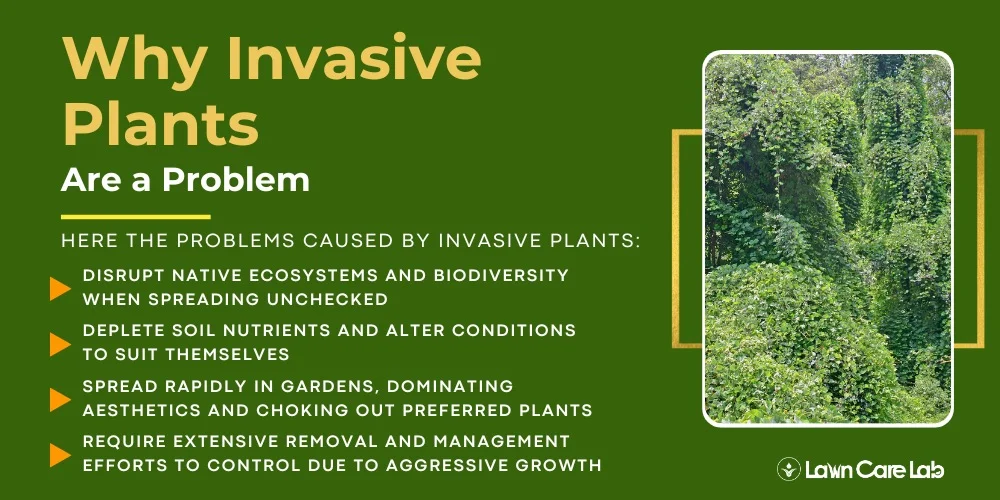
Curious about why invasive plants are deemed problematic? Well, they’re notorious for causing chaos in our ecosystems.
Their competitive growth outshines native plants while interfering with biodiversity and soil wellness.
Beyond causing ecological disturbances, they’re also a gardener’s nightmare due to their rapid spread in cultivated areas, impacting both the beauty and functionality of gardens.
The ecological implications of unchecked growth
Consider how aggressive non-native plants can negatively affect local ecosystems.
They interfere with the natural balance of life, forcing out local flora, which then has a knock-on effect on fauna dependent on these plants.
Additionally, these unwelcome guests can harm soil quality and use up essential nutrients, putting extra pressure on the environment’s capacity to sustain varied forms of life.
Disruption of natural biodiversity
The unchecked spread of invasive plants can seriously mess with our local biodiversity and cause some major ecological problems.
For one, changing their food sources and habitats can mess with our pollinators.
It can also greatly impact wildlife by messing with the food chain and disrupting their living spaces.
The ecological balance can also be thrown off, with native species being pushed out and natural interactions disrupted.
Plus, our ecosystem services like air and water quality, soil health, and climate control can be at risk.
All of this can be a big danger to the health and sustainability of our environment.
Soil health and nutrient depletion concerns
Invasive plants harm soil health and nutrient levels by changing soil chemistry to suit themselves, stripping away vital nutrients, and reducing microbial diversity.
On the bright side, we can use soil remediation strategies to bring back nutrient cycling, boost soil fertility, and promote healthier ecosystems. Remember, your active involvement is key in this battle for turf.
The aesthetic and practical challenges for gardeners
Invasive plants can be a real pain for gardeners, messing up the look and the practical aspects of your garden. They can dominate your garden’s aesthetic, overshadowing other plants and potentially ruining your design. They also grow like wildfire, making them hard to keep in check.
Moreover, they can outcompete other plants by altering their growing conditions and detract from the overall appeal of your garden.
To deal with these issues, it’s important to look into effective ways to manage these stubborn invaders.
Proven Methods to Combat Invasive Plants
Let’s delve into established techniques for tackling intrusive vegetation.
The first tactic is manual extraction, a tactile method that directly combats these species.
The other strategy is ecological management, a green solution that harnesses the natural equilibrium of our environment.
Physical removal techniques
Physical removal methods are crucial in your fight against invasive plant species. Yanking them out by hand works wonders for minor issues as it tackles the problem from the root.
However, you might need to bring in some tools or machines for more serious invasions. This can speed up the process and halt the spread and growth of these unwanted plants.
Hand-pulling: The manual approach
Hand-pulling can be a practical and instant solution when dealing with small infestations of invasive plants as long as you uproot all stems and roots.
Here’s a quick rundown on how to go about it:
- Get the hang of the right hand-pulling techniques
- Identify the tools that can aid you in the process
- Learn how to stop these plants from growing back
- Understand how different soil types affect the hand-pulling process.
Using tools and machinery for larger infestations
For serious infestations, using more than just your hands is necessary. Consider getting heavy-duty equipment like mowers or weed whips, especially for thick growth.
It’s important to consider the cost-effectiveness of these tools. You might also want to look into hiring professionals for the best outcome.
Whatever you do, remember to stay safe and aim to stop the infestation without harming the plants you want to keep.
Biological control: Nature’s way of balance
Dive into the world of biological control, the natural system that keeps invasive species under control.
Consider how bringing in natural predators from a plant’s original habitat can be a lasting, non-toxic solution.
Also, ponder on companion planting, a smart approach that uses the idea of competition to stop invasive plants in their tracks.
Introducing natural predators
Using natural predators to combat invasive plants can restore ecological balance. However, it requires careful management as it can impact ecosystems significantly.
Nevertheless, there’s a bright side, too, with numerous successful introductions recorded.
Now, let’s switch gears and delve into the role of companion planting in warding off these unwelcome invaders.
The role of companion planting in deterring invaders
Companion planting can help manage invasive plants by pairing native groundcovers with chosen species. This creates beneficial pairings that fend off unwelcome species and fill gaps in your ecosystem.
Prevention: Keeping Invaders at Bay
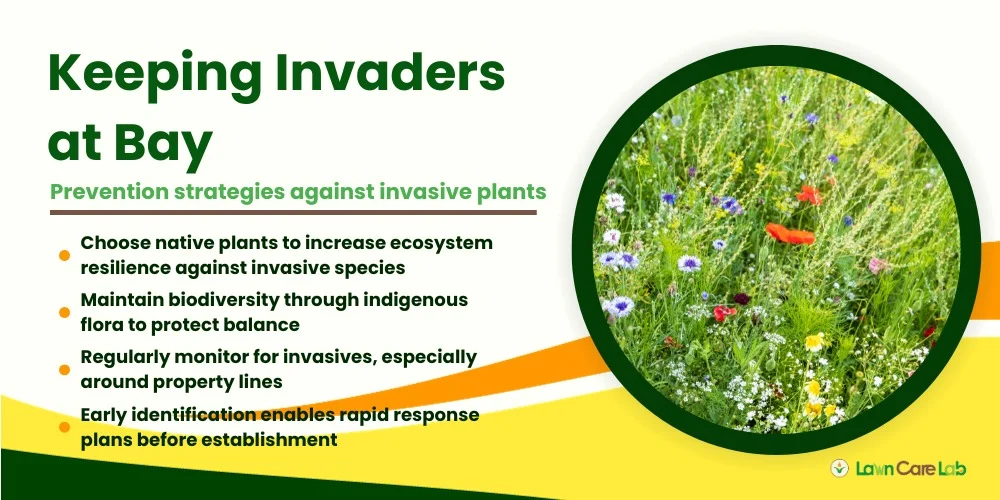
Choosing native flora for your garden isn’t just about looks; it’s a smart tactic to combat invasive species.
Regular checks on your garden can help spot these uninvited guests early, making it easier for quick and successful removal.
Think of these precautions as your first line of protection in the battle against intrusive plants.
Choosing native plants for a resilient garden
If you want a resilient garden, why not consider native plants? They’re naturally adapted to the climate and soil where you live, which gives them a fighting chance against unwelcome outsiders.
Choosing natives is a great way to nurture the local ecosystem and protect our biodiversity.
It’s a win for your garden, local critters, and the environment.
The benefits of local flora in landscaping
Using native plants in your garden strengthens its resistance and provides environmental perks by supporting the local wildlife. Native plants fortify your garden’s resistance to local diseases and pests.
These indigenous plants flourish with little maintenance, fostering sustainability. Moreover, the use of native species encourages biodiversity, promoting the concept of sustainable gardening.
Cultivating a diverse and balanced garden ecosystem
Diversify your garden with native plants to avoid pests. Choose indigenous flora, promote biodiversity, and maintain ecological balance.
It’s clever and forward-thinking to bring in natural predators.
Don’t forget it’s vital to act early to stop intrusive species from establishing themselves and spoiling the tranquility of your garden.
Regular monitoring and early intervention
To counter the threat of invasive plants, it’s essential to monitor your surroundings routinely, especially around your property lines. Utilize modern methods like drone surveys or digital maps to spot any invasive species early. Becoming adept at identifying such plants will speed up your response.
To prevent invasive species and rebuild ecosystems, follow these four steps: create a regular inspection routine, learn about invasive species, devise quick action plans, and reintroduce native plants.
Conclusion: Reclaiming Your Lawn from Unwanted Guests
Now, you’re equipped with innovative strategies to remove your lawn from annoying intruders. These eco-friendly techniques not only help in removing invasive plants effectively, but they also offer long-lasting solutions to maintain your lawn’s health.
By comprehending your lawn’s ecology, you can use nature’s mechanisms to reduce chemical dependency. Regular check-ups and prompt action are key to controlling these unwanted guests, thus minimizing their impact.
With persistence and smart tactics, you can return the power to your preferred plants. Winning this war of reclaiming your lawn is crucial for both its sustainability and visual charm.
- How to Create a Lawn Care Schedule for Southern Climates - October 30, 2024
- How to Use Compost Tea to Boost Lawn Growth and Soil Health - October 23, 2024
- The Best Grasses for Saltwater-Exposed Lawns: Coastal Lawn Care - October 17, 2024

